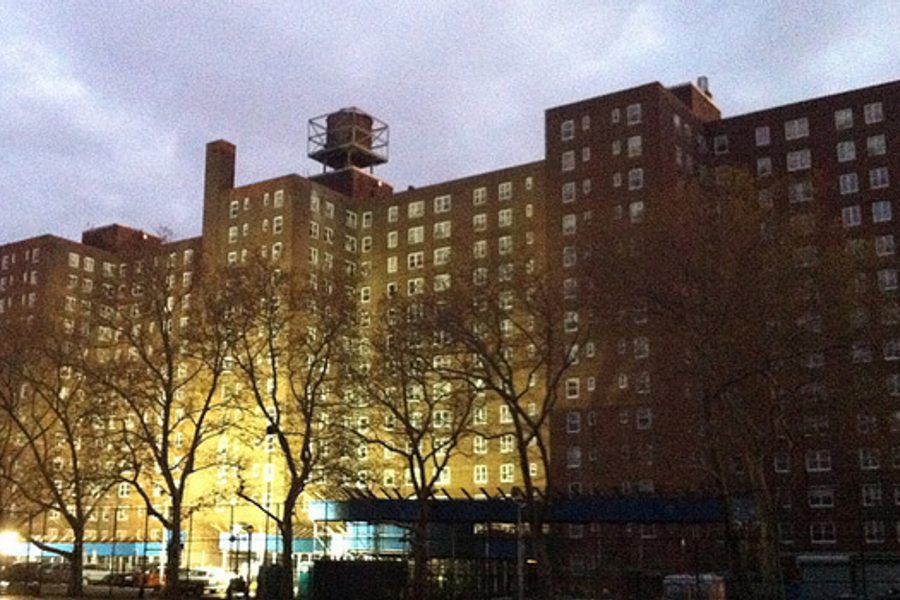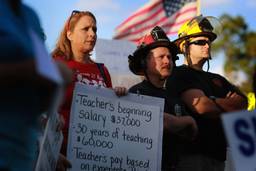No Room of Their Own for New Yorkers in Need
Privatization threatens New York’s public housing system.
Michelle Chen

The city that never sleeps may become the city where the poor can’t afford a place to sleep. While New Yorkers are used to battling astronomical housing costs and wedging themselves into closet-sized studios, hundreds of thousands of working-class residents have somewhere to call home thanks to the city’s public housing system. But now that already faulty system is facing a new assault from real estate developers.
In late July, New Yorkers from low and modest-income neighborhoods gathered at Pace University in Lower Manhattan to air their grievances against the city’s public housing authority, NYCHA.
Displaying signs proclaiming “Housing is a Human Right” and “Save Meltzer Park,” many in the crowd came to speak out about day-to-day struggles like rising rents and deteriorating buildings. But the focal point of the protests was the city’s proposal to lease 14 parcels of NYCHA land, scattered on eight housing complexes across the city, to private developers. Many housing activists fear the plan would pave the way for even more assaults on the city’s embattled public housing system and enable real estate financiers to consume more and more public-owned and community-oriented spaces.
Rose Clifton, who is pushing 80 and serves as Resident Association President of Brooklyn’s Park Rock development, came to the protests to voice frustration with inadequate funding and neglected repair needs, like mold and floods, in addition to an overall sense that the city was neglecting poor tenants even as they struggle with the rising rents. Unlike the city’s unregulated private rental market, NYCHA housing is largely geared toward lower-income households, with rents set according to residents’ ability to pay (based on a federal formula that adjusts costs around a threshold of about 30 percent of income). But Clifton said even with government support, housing costs still put a squeeze on tenants.
Under NYCHA’s rent rates, Clifton said, “The more money you make, the more they take. There’s people in there paying $1,000… [This] housing used to be for low-rent people.”
Still, despite Clifton’s sense that costs are rising above what her neighbors can afford, the city’s public housing system remains an increasingly isolated bastion of low rents: tenants pay an average of $436 per month and the average resident household income is roughly $23,000 a year.
The pro-business administration of Mayor Michael Bloomberg points out to disgruntled tenants that the agency itself is strapped for cash. Earlier this year, the deficit kamikaze of federal sequestration blasted a $200 million hole in NYCHA’s budget. Though the City Council has since pledged some funds to shrink the shortfall to about $150 million, the infusion is aimed at just keeping basic community facilities open and staffed, including dozens of NYCHA-run senior centers.
On top of the heavy cuts, NYCHA faces a groaning backlog of hundreds of thousands of repair requests, with many families waiting years for basic sink and electrical repairs. Last year, Superstorm Sandy heaped even more damage onto already dilapidated buildings.
NYCHA’s budget constraints have for the past decade kept it from expanding to meet the city’s deep needs for affordable housing, which the volatile economy has further exacerbated in recent years. According to studies by New York University’s Furman Center, nearly 80 percent of low-income households struggle to pay rent, with many stuffed into overcrowded apartments.
Outside of its dedicated housing for the poor, NYCHA also administers “Section 8” vouchers that can bridge affordable-housing gaps by giving tens of thousands of struggling families subsidies for renting in the private housing market. But in addition to undermining NYCHA’s own housing, the latest spate of federal cuts has limited New York’s Section 8 funding as well, threatening to kick some 1,200 low-income New Yorkers off the payments that keep them housed in private apartments.
To climb out of its fiscal hole, NYCHA proposed a sweeping land lease plan earlier this year. This initiative would effectively allow for the construction of luxury high rises on public-housing properties that have been historically occupied by the city’s poor. According to recently released design plans, this “infill development” would saddle eight NYCHA projects with new privately run developments. The city emphasizes that while a lease would typically last 99 years, it would technically not amount to a sale of NYCHA land — a distinction critics write off as mere political semantics.
According to NYCHA’s draft plan, the leasing program would yield $30-$50 million in annual revenue. The city has promised to ensure that new developments will target currently underutilized spaces, that a portion of new units are reserved for low-income residents and that current tenants are not displaced. In August, following public outcry, the city pulled back from its initial plans by slowing down the timeline for implementing the leasing proposal.
But with the city about to elect a new mayor, activists foresee more battles on the horizon for the public housing community. Though the lease plan seems to be on hold for now, it has stirred growing fears that the city is moving toward backdoor privatization of government-sponsored housing, which shelters about 600,000 people citywide. Activists suspect the promise of a short-term revenue boost from NYCHA’s proposal masks an underlying plan to turn over more and more of the public trust to corporations and wealthier residents.
“Once they get their toe in the door, there will be no end to how they look at public housing land, and their ability to successfully develop housing and make money from that land,” says Damaris Reyes, a Baruch Houses resident who directs the tenant advocacy group Good Old Lower East Side.
At Smith Houses, a low-income community on prime waterfront property facing the Brooklyn Bridge, luxury developers have proposed to erect buildings as high as 50 stories, geared toward “market rate” or higher-income tenants. The gleaming towers would dwarf the project’s older buildings, where the city was recently ordered by a court to address hundreds of backlogged repair requests.
Aixa Torres, head of Smith Houses’ resident association, told the New York Daily News, “It’s appalling. We won’t have any sun. They’re going to literally squeeze my residents like they’re roaches and then they’re going to build this huge beautiful complex. You want to talk about the ‘Tale of Two Cities?’ ”
At an alternative “People’s Hearing” staged by activists near the official hearing at Pace University, Jonathan Gardenhire, Vice President of Smith Houses’ resident association, condemned the plans as an assault on the core principles of public housing: “These plans go against NYCHA’s own mission statement to preserve public housing…. This looks like the first step in the true demolition of public housing as we know it.”
The city claimed that the leases would provide crucial capital for rehabilitating old properties like Smith, citing unmet capital needs that are projected to reach $13.4 billion in five years. But community groups are calling on the city to work with residents to find a budget solution that does not involve giving the real estate industry the right to build on public housing properties.
The NYC Alliance to Preserve Public Housing, a coalition of advocacy and social service organizations, has pushed for a more inclusive NYCHA budget that engages the communities at the heart of its affordable-housing mandate. The group demands that any restructuring plans preserve social centers, such as the senior facilities that provide services and recreation for aging residents. Activists also want to ensure that NYCHA’s proposal for more “funding flexibility” in its development partnerships won’t be used to “waive basic resident rights and protections, or impose new restrictions.” In addition, the alliance seeks long-term infrastructural improvements to deal with the deteriorating housing conditions as well as the termination of certain controversial payments, such as the $75 million in annual subsidies for police on NYCHA sites — a “security” service that some have accused of abusing residents.
An epic turf war
The battle for housing and public space is, of course, ingrained in Gotham’s history — from the 1907-1908 rent strike led by Lower East Side factory girls to community organizers’ revolt against Robert Moses-style “urban renewal” in the 1960s. Yet today, under the crush of the recession as well as years of deregulation policies that have eroded rent controls for the poor, the city’s lower-income neighborhoods face unprecedented threats of displacement.
According to a 2009 State Assembly Speaker’s report [PDF], about 30 percent of apartments across the New York metro area that were once “considered affordable to low-income families” have vanished over the past decade. The attrition has been fueled by a stream of neoliberal rent deregulation that has enabled landlords of low-income apartments to raise prices toward market rates. As the white-hot real estate industry invades neighborhoods of the poor, immigrants and people of color, gentrification is displacing working-class families and undermines the communities that, while economically marginalized, have historically anchored the city’s culture.
Some of the more obvious cultural erosion can be seen in the shrinkage of legendary artist enclaves of SoHo and the West Village, or the shuttering of sketchy yet fiercely mourned nightspots and venues like CBGBs. Other shifts have been more insidious, like the demographic morphing of Harlem and Chinatown, where working-class families of color have lost ground to young white professionals.
The Bloomberg administration claims housing affordability is a priority and that the city is “on track” to create about 165,000 affordable units. Still, swaths of the city remain “rent burdened”: an estimated one-third of New Yorkers lose over half their monthly incomes to rent. Meanwhile, the waiting list for NYCHA housing has reached about 160,000. And while the city has boasted of creating new “affordable” housing over the past decade, according to an analysis by the Association for Neighborhood and Housing Development, about one third of those supposedly cheaper units are still priced outside the median income range of local residents.
The gentrification of the Lower East Side is emblematic of this geographic class struggle. Luxury developments, hip bars and trendy boutiques have brought a wave of affluent new residents into previously so-called blighted areas, but they’ve also reshaped the social fabric of old immigrant enclaves. To residents like Reyes, the city has already sided firmly with capital, and public housing is the last frontier.
“In Manhattan and in New York, where is the land? The land that is left is in two major places: public parks and public housing,” Reyes says. “So it’s no surprise to us that these proposals are on the table to encourage private developers [to] build on this land that they see as ‘excess land,’ and that these proposals are largely benefiting these developers.”
The upshot to NYCHA’s pro-corporate overhaul plan is that it has inspired new neighborhood alliances of opposition. At Smith Houses, for example, residents from the Latino and Chinese communities, which usually tend to occupy separate cultural spheres on the Lower East Side, have begun organizing together for more and better affordable housing.
Cathy Dang, organizing director at the Chinatown-based advocacy organization CAAAV, tells In These Times that the common cause of resisting gentrification and preserving public housing is “bringing folks together to address the misfortunes of NYCHA’s failure to address the backlog of repairs [and] also the infill development plant that’s going to push out a lot of people.” About the cross-community Latino and Chinese mobilization, she adds, “Finally, tenants across races are uniting to demand more from NYCHA.”
Outside of the hearing at Pace, Naomi Colon, head of the Tenant Association at Marcy Houses (of Jay-Z fame), told ITT that she appreciates her neighborhood’s diversity and doesn’t have a problem with new people moving in. She just wants to ensure that public housing remains inclusive.
“All races, they’re all welcome,” she said. “What we want is for them not to privatize and take that down because where are we all gonna go? Where are people gonna go? If this is affordable housing for people like us, we cannot afford their thousand dollar rents and all of that.” Asked where she would be if she couldn’t live at Marcy, she replied, “I’m not gonna go. I guess I would have to fight until I can’t fight no more.”
A version of this story ran in the October 2013 print issue of In These Times under the headline “New York’s Epic Turf Wars.”
Michelle Chen is a contributing writer at In These Times and The Nation, a contributing editor at Dissent and a co-producer of the “Belabored” podcast. She studies history at the CUNY Graduate Center. She tweets at @meeshellchen.









